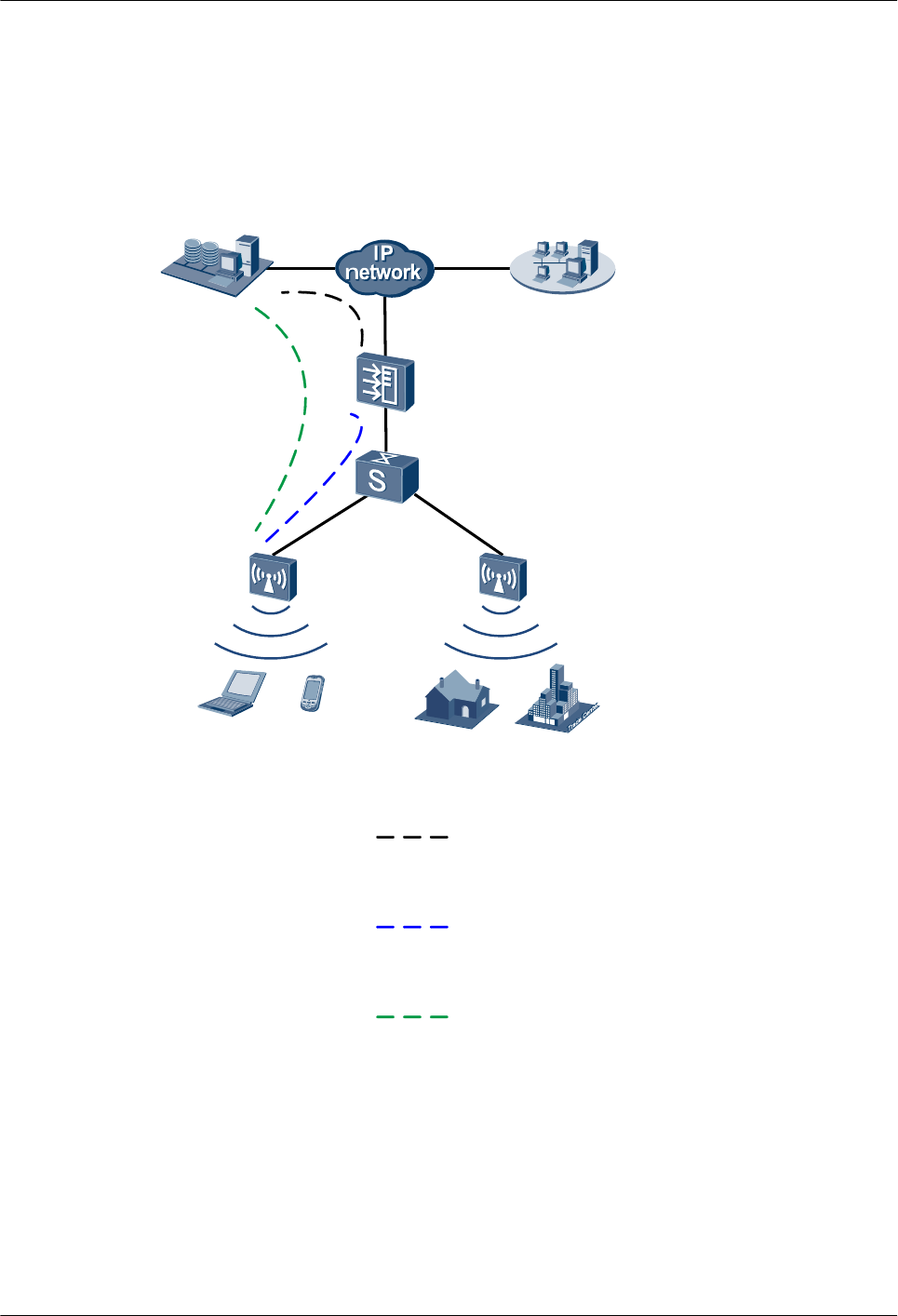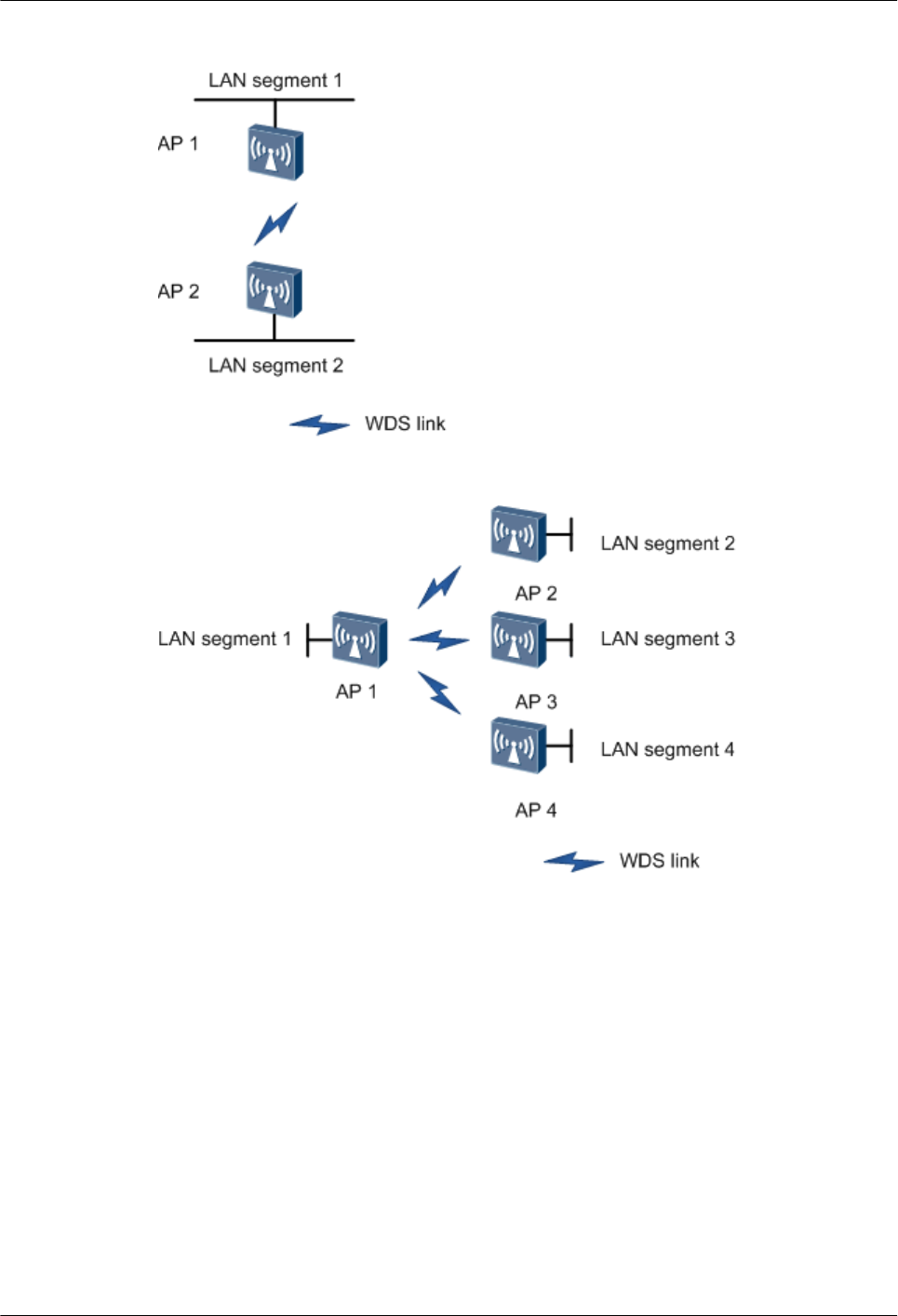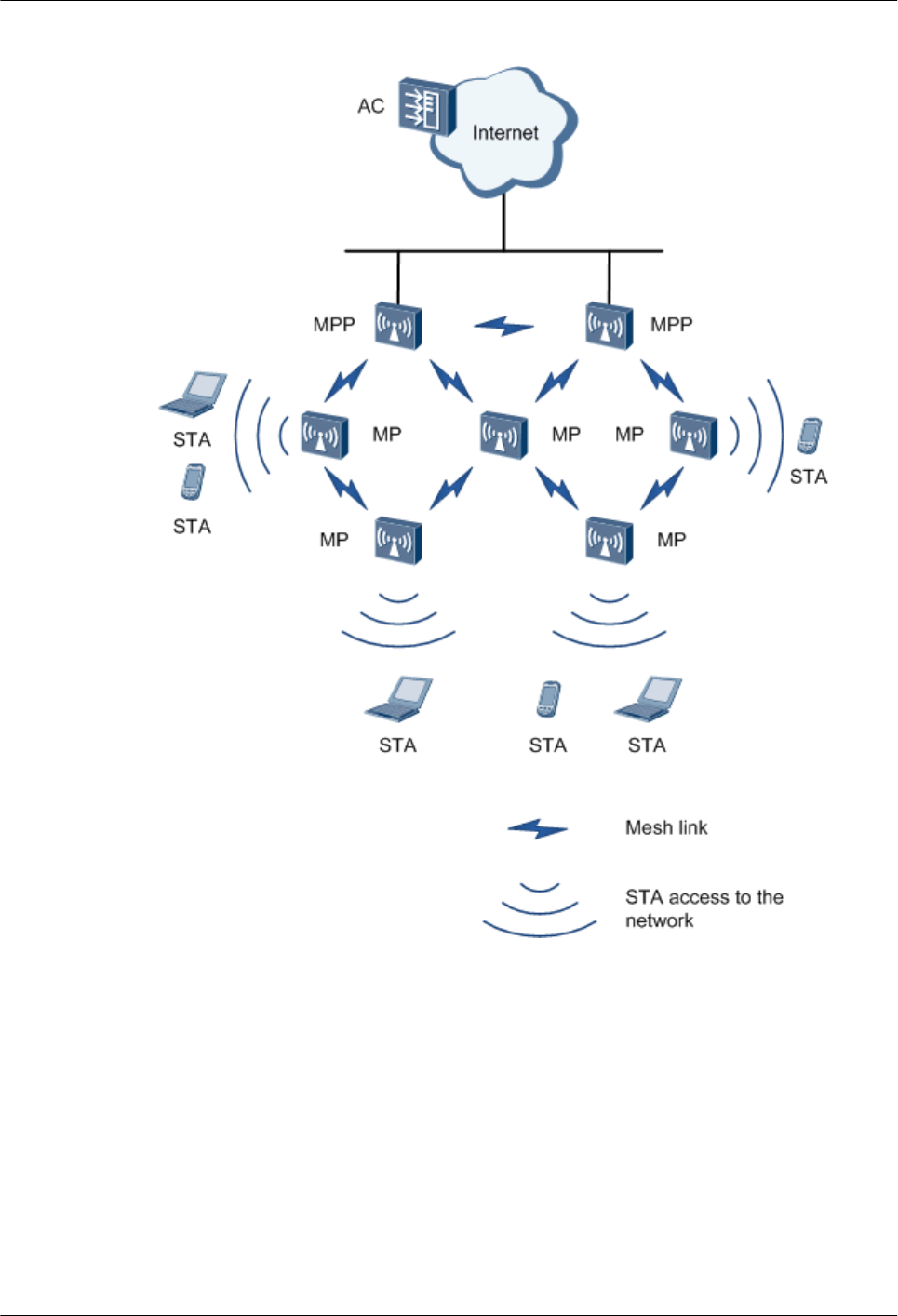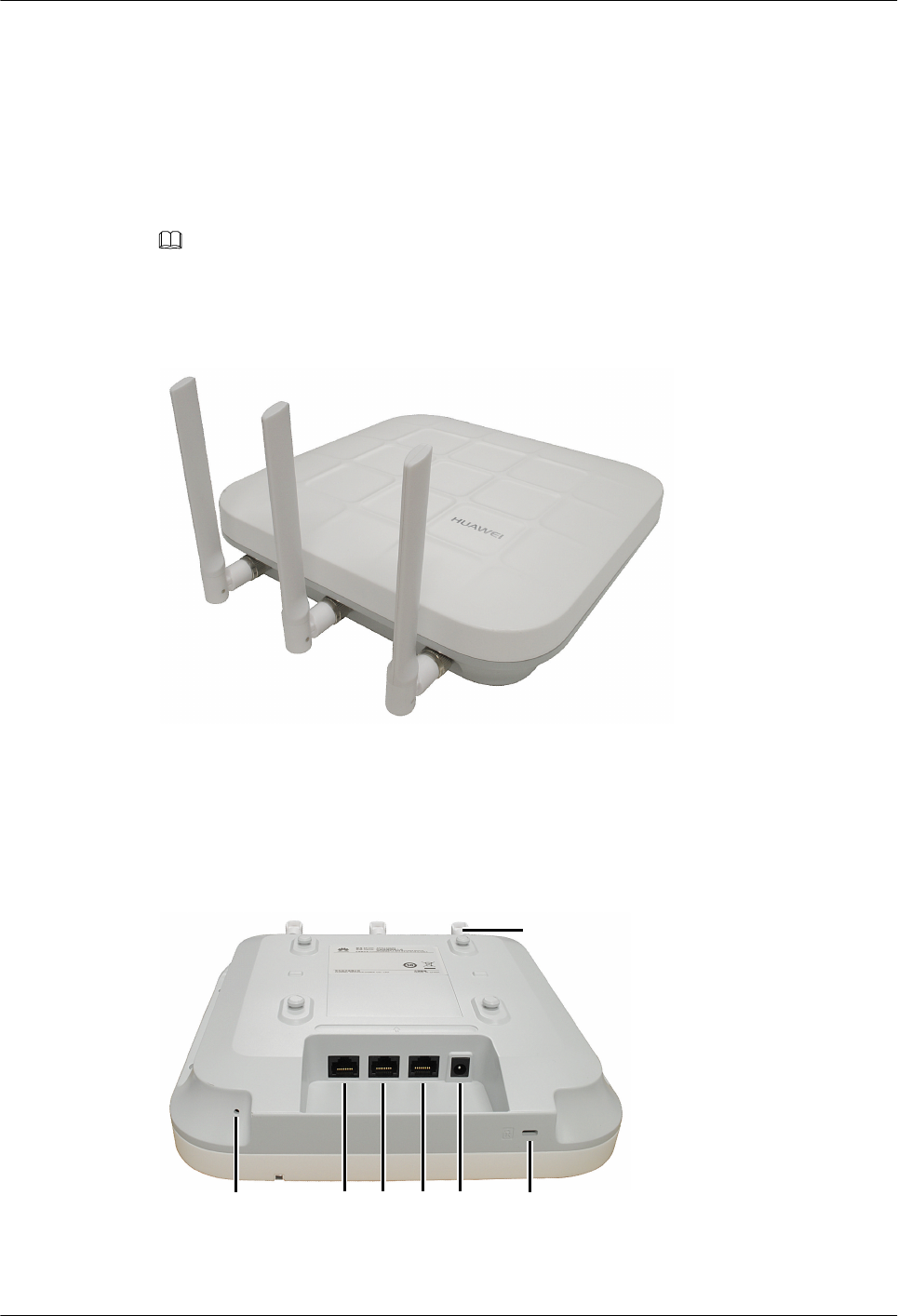Huawei Technologies AP505130DN Wireless LAN Access Point User Manual Product Description
Huawei Technologies Co.,Ltd Wireless LAN Access Point Product Description
Contents
User manual-1

Huawei AP5130DN Access Points
Product Description
Issue 01
Date 2013-12-30
HUAWEI TECHNOLOGIES CO., LTD.

Copyright © Huawei Technologies Co., Ltd. 2013. All rights reserved.
No part of this document may be reproduced or transmitted in any form or by any means without prior written
consent of Huawei Technologies Co., Ltd.
Trademarks and Permissions
and other Huawei trademarks are trademarks of Huawei Technologies Co., Ltd.
All other trademarks and trade names mentioned in this document are the property of their respective holders.
Notice
The purchased products, services and features are stipulated by the contract made between Huawei and the
customer. All or part of the products, services and features described in this document may not be within the
purchase scope or the usage scope. Unless otherwise specified in the contract, all statements, information,
and recommendations in this document are provided "AS IS" without warranties, guarantees or representations
of any kind, either express or implied.
The information in this document is subject to change without notice. Every effort has been made in the
preparation of this document to ensure accuracy of the contents, but all statements, information, and
recommendations in this document do not constitute a warranty of any kind, express or implied.
Huawei Technologies Co., Ltd.
Address: Huawei Industrial Base
Bantian, Longgang
Shenzhen 518129
People's Republic of China
Website: http://enterprise.huawei.com
Issue 01 (2013-12-30) Huawei Proprietary and Confidential
Copyright © Huawei Technologies Co., Ltd.
i

Contents
1 About This Document.............................................................................................................. 0
1 Product Positioning and Characteristics...................................................................................1
1.1 Product Positioning.........................................................................................................................................................2
1.2 Product Characteristics...................................................................................................................................................6
2 Hardware Structure.......................................................................................................................9
2.1 AP5130DN...................................................................................................................................................................10
3 Product Features...........................................................................................................................13
3.1 WLAN Features............................................................................................................................................................14
3.2 Network Features..........................................................................................................................................................14
3.3 QoS Features.................................................................................................................................................................15
3.4 Security Features..........................................................................................................................................................15
3.5 Maintenance Features...................................................................................................................................................16
3.6 BYOD...........................................................................................................................................................................16
3.7 Locating Service...........................................................................................................................................................16
3.8 Spectrum Analysis........................................................................................................................................................16
4 Technical Specifications.............................................................................................................18
4.1 Basic Specifications......................................................................................................................................................19
4.2 Radio Specifications.....................................................................................................................................................19
4.3 Standards Compliance..................................................................................................................................................22
Huawei AP5130DN Access Points
Product Description Contents
Issue 01 (2013-12-30) Huawei Proprietary and Confidential
Copyright © Huawei Technologies Co., Ltd.
ii

1.1 Product Positioning
Table 1-1 Product positioning
Product
Model
Frequency
Band
IEEE
Standard
Compliance
Positioning Usage
Scenario
AP5130DN Dual band:
l2.4 GHz
l5 GHz
The AP5130DN
can provide
services
simultaneously
on the 2.4 GHz
and 5 GHz
frequency bands
to support more
access users.
IEEE 802.11a/
b/g/n/ac
The cost-
effective
AP5130DN
supports 3 x 3
MIMO and
provides
comprehensive
service support
capabilities. It is
deployed
indoors and
features high
reliability, high
security, simple
network
deployment,
automatic AC
discovery and
configuration,
and real-time
management
and
maintenance.
Huawei
AP5130DN
complies with
IEEE 802.11ac
and can provide
gigabit access
for wireless
users. This high
capacity greatly
improves user
experience on
wireless
networks.
The AP5130DN
provides
802.11n/ac
wireless access
networks for
places with
simple building
structure, small
size, dense
users, and high
capacity
demands, such
as small and
medium
enterprises and
branches.
The AP5130DN
can be flexibly
deployed and
work in both fit
AP and bridge
mode.
The AP5130DN can work as a Fat AP or Fit AP and switch flexibly between the two working
modes based on the network plan.
Huawei AP5130DN Access Points
Product Description 1 Product Positioning and Characteristics
Issue 01 (2013-12-30) Huawei Proprietary and Confidential
Copyright © Huawei Technologies Co., Ltd.
2

When the wireless network scale is small, customers need to purchase only AP products and set
the APs to work as Fat APs. As the network scale expands, tens of or hundreds of APs exist on
the network. To simplify network management, customers are advised to purchase ACs to
perform centralized management on the APs and set the APs to work as Fit APs.
Typical networking modes are as follows:
Figure 1-1 Fit AP networking (AP mode)
AP n
AP1
……
NMS
AC
Authentication system
Switch
Management channel between
NMS and AC
Management channel between the
AC and the AP and data channel
Where data flows are
encapsulated with CAPWAP
Channel where data flows are not
encapsulated with CAPWAP
Business
users
Residential
users
STA STA
In this networking, the AP functions as a fit AP and provides only data forwarding functions.
The AC is responsible for user access, AP go-online, AP management, authentication, routing,
security, and QoS.
Huawei AP5130DN Access Points
Product Description 1 Product Positioning and Characteristics
Issue 01 (2013-12-30) Huawei Proprietary and Confidential
Copyright © Huawei Technologies Co., Ltd.
3

Figure 1-2 Fit AP networking (WDS mode: point-to-point)
Figure 1-3 Fit AP networking (WDS mode: point-to-multipoint)
In this networking, the AP connects two or more independently wired or wireless LANs through
wireless links to construct a network on which users can exchange data. In Wireless Distribution
System (WDS) mode, the AP supports point-to-point (P2P) and point-to-multipoint (P2MP)
networking modes. With 5 GHz and 2.4 GHz frequency bands, the AP can implement wireless
bridging and access functions.
Huawei AP5130DN Access Points
Product Description 1 Product Positioning and Characteristics
Issue 01 (2013-12-30) Huawei Proprietary and Confidential
Copyright © Huawei Technologies Co., Ltd.
4

Figure 1-4 Fit AP mesh networking
On the preceding network, APs function as mesh points (MPs) and are fully-meshed to establish
an auto-configured and self-healing wireless mesh network (WMN). APs with the gateway
function can work as the mesh portal points (MPPs) through which the WMN can provide access
to the Internet. Terminals connect to APs to access the WMN. The WMN uses dedicated mesh
routing protocols to guarantee high transmission quality and is more applicable to scenarios that
require high bandwidth and highly stable Internet connections.
Huawei AP5130DN Access Points
Product Description 1 Product Positioning and Characteristics
Issue 01 (2013-12-30) Huawei Proprietary and Confidential
Copyright © Huawei Technologies Co., Ltd.
5

Figure 1-5 Fat AP networking
AP n
AP1
……
Switch
STA STASTA STA
On the preceding network, the device functions as a Fat AP to implement functions such as user
access, authentication, data security, service forwarding, and QoS.
1.2 Product Characteristics
The AP5130DN has the following advantages on a WLAN.
Huawei AP5130DN Access Points
Product Description 1 Product Positioning and Characteristics
Issue 01 (2013-12-30) Huawei Proprietary and Confidential
Copyright © Huawei Technologies Co., Ltd.
6

Product
Characteristics
Description
High-speed and
reliable wireless
access
lCompatibility with IEEE 802.11a/b/g/n/ac
l3 x 3 MIMO and a maximum rate of 1.75 Gbit/s
lLink aggregation of dual Ethernet ports
lSupports Wi-Fi Multimedia (WMM) and priority mapping on the
air interface and wired interface.
lSupports wired link integrity check.
lSupports load balancing.
lSupports roaming without service interruption in Fit AP mode.
lSupports AC dual-link backup in Fit AP mode.
lSupports 11n beamforming.
lLatest 802.11ac chip with higher performance and wider coverage
lSupports airtime scheduling which ensures fairness in channel
occupation time for all users.
NOTE
This function is not supported in V200R003C00.
Comprehensive
user access control
capability
lSupports access control lists (ACLs) and implements user access
control based on the user group policy.
lProvides fine-grained bandwidth management for each user.
lSupports user isolation policies.
lSupports unified authentication on the AC in Fit AP mode.
lIdentifies the device type according to the organizationally unique
identifier (OUI) in the MAC address, user agent (UA) information
in an HTTP packet, and DHCP options in Fit AP mode.
lThe RADIUS server delivers packet forwarding, security, and QoS
policies according to the device type carried in the RADIUS
authentication and accounting packets in Fit AP mode.
High network
security
lOpen system authentication
lWEP authentication/encryption
lWPA/WPA2-PSK authentication and encryption
lWPA/WPA2-802.1x authentication and encryption
lWAPI authentication and encryption
lSupports wireless intrusion detection system (WIDS), including
rogue AP and STA detection, attack detection, STA/AP blacklist
and whitelist.
Huawei AP5130DN Access Points
Product Description 1 Product Positioning and Characteristics
Issue 01 (2013-12-30) Huawei Proprietary and Confidential
Copyright © Huawei Technologies Co., Ltd.
7

Product
Characteristics
Description
Flexible
networking and
environment
adaptability
lProvides flexible networking capabilities and applies to various
application scenarios. Mesh and WDS scenarios are supported only
in Fit AP mode.
lHas strong environment adaptability. The AP can automatically
select the transmission rates, channels, and transmit power to adapt
to various radio environments and avoid interference in real time.
lAdjusts bandwidth allocation based on the user quantity and
environment to improve user experience.
lSupports the MIMO antenna system, connects to the external dual-
band antenna (2.4 GHz and 5 GHz), and flexibly adjusts antenna
directions.
lIdentifies interference sources such as baby monitors, Bluetooth
devices, digital cordless phones (at 2.4 GHz frequency band only),
wireless audio transmitters (at both the 2.4 GHz and 5 GHz
frequency bands), wireless game controllers, and microwaves in Fit
AP mode and works with eSight to locate interference sources and
display spectrums.
Easy device
management and
maintenance
lAutomatically goes online and loads the configuration, and supports
plug-and-play (PnP) in Fit AP mode.
lSupports batch upgrade.
lAllows real-time monitoring on the network management system
(NMS) to facilitate remote configuration and fast fault location.
lSupports the Link Layer Discovery Protocol (LLDP) to implement
automatic link discovery and obtain the network topology.
Huawei AP5130DN Access Points
Product Description 1 Product Positioning and Characteristics
Issue 01 (2013-12-30) Huawei Proprietary and Confidential
Copyright © Huawei Technologies Co., Ltd.
8

2.1 AP5130DN
Appearance
Figure 2-1 shows AP5130DN appearance.
NOTE
The actual device appearance may be different from the following device appearance, but these differences
will not affect device functions.
Figure 2-1 AP5030DN appearance
Port
The following figure shows ports on the AP5030DN.
Figure 2-2 AP5030DN ports
25 3 4 1 6
7
As shown in Figure 2-2, each port can be described as follows:
Huawei AP5130DN Access Points
Product Description 2 Hardware Structure
Issue 01 (2013-12-30) Huawei Proprietary and Confidential
Copyright © Huawei Technologies Co., Ltd.
10

l1. Input port for 12 V DC power supply
l2. Default button: restores factory settings if you hold down the button more than 3 seconds.
l3. GE1: 10/100/1000M port used to connect to the wired Ethernet.
l4. GE0/PoE: 10/100/1000M port used to connect to the wired Ethernet. The port can connect
to a PoE power supply to provide power for APs.
l5. Console port: connects to the maintenance terminal for AP configuration and
management.
l6. Lock port: protects the AP against theft.
l7. Dual-band antenna port
NOTE
Different power adapters are delivered with the AP products according to standards in the countries or
regions where the AP products are delivered. These countries and regions are identified by the barcode on
an AP's nameplate, including:
lEU (Europe)
lUK (United Kingdom)
lCN (China)
lAU (Australia)
lUS (United States)
lUSA (the AP is sold only in the U.S)
LED Indicators
NOTE
Indicator colors may vary slightly at different temperature.
Type Color Status Description
Default
status after
power-on
Green Steady on The AP is just powered on and the software is not
started yet.
Software
startup
status
Green Steady on
after
blinking
once
After the system is reset and starts uploading the
software, the indicator blinks green once. Until the
software is uploaded and started, the indicator
remains steady green.
Running
status
Green Blinking
once every
2s (0.5 Hz)
lThe system is running properly, the Ethernet
connection is normal, and STAs are associated
with the AP.
lThe system enters the Uboot CLI.
Blinking
once every
5s (0.2 Hz)
The system is running properly, the Ethernet
connection is normal, and no STA is associated with
the AP. The system is in low power consumption
state.
Huawei AP5130DN Access Points
Product Description 2 Hardware Structure
Issue 01 (2013-12-30) Huawei Proprietary and Confidential
Copyright © Huawei Technologies Co., Ltd.
11

Type Color Status Description
Alarm Green Blinking
once every
0.25s (4
Hz)
lThe software is being upgraded.
lAfter the software is uploaded and started, the AP
working in Fit AP mode requests to go online on
the AC and maintains this state until it goes
online successfully on the AC (before the
CAPWAP link is established).
lThe AP working in Fit AP mode fails to go online
on the AC (the CAPWAP link disconnects).
Fault Red Steady on A fault that affects services has occurred, such as a
DRAM detection failure or system software loading
failure. The fault cannot be automatically rectified
and must be rectified manually.
Huawei AP5130DN Access Points
Product Description 2 Hardware Structure
Issue 01 (2013-12-30) Huawei Proprietary and Confidential
Copyright © Huawei Technologies Co., Ltd.
12

3 Product Features
About This Chapter
3.1 WLAN Features
3.2 Network Features
3.3 QoS Features
3.4 Security Features
3.5 Maintenance Features
3.6 BYOD
3.7 Locating Service
3.8 Spectrum Analysis
Huawei AP5130DN Access Points
Product Description 3 Product Features
Issue 01 (2013-12-30) Huawei Proprietary and Confidential
Copyright © Huawei Technologies Co., Ltd.
13

3.1 WLAN Features
WLAN features supported by the AP are as follows:
lCompatibility with IEEE 802.11a/b/g/n/ac
lMaximum rate: 1.75 Gbit/s
lMaximum ratio combining (MRC)
lMaximum-likelihood detection (MLD)
lData unit aggregation, including A-MPDU (Tx/Rx) and A-MSDU (Rx only)
lSupports 802.11 dynamic frequency selection (DFS).
lShort GI in 20 MHz, 40 MHz, and 80 MHz modes
lPriority mapping and packet scheduling based on a Wi-Fi Multimedia (WMM) profile to
implement priority-based data processing and forwarding
lAutomatic and manual rate adjustment (the rate is adjusted automatically by default)
lWLAN channel management and channel rate adjustment
NOTE
For details about WLAN channel management, see the Country Code & Channel Compliance
Table.
lAutomatic channel scanning and interference avoidance
lService set identifier (SSID) hiding
lSignal sustain technology (SST)
lUnscheduled automatic power save delivery (U-APSD)
lControl and Provisioning of Wireless Access Points (CAPWAP) in Fit AP mode
lAutomatic login in Fit AP mode
lWireless distribution system (WDS) in Fit AP mode
lMesh networking in Fit AP mode
lMulti-user CAC
NOTE
This function is not supported in V200R003C00.
3.2 Network Features
Network features supported by the AP are as follows:
lCompliance with IEEE 802.3u
lAuto-negotiation of the rate and duplex mode and automatic switchover between the Media
Dependent Interface (MDI) and Media Dependent Interface Crossover (MDI-X)
lSSID-based VLAN assignment
lVLAN trunk on uplink Ethernet ports
l4094 VLAN IDs (1-4094) and a maximum of 16 virtual APs (VAPs) for each radio
lAP control channel in tagged and untagged mode
Huawei AP5130DN Access Points
Product Description 3 Product Features
Issue 01 (2013-12-30) Huawei Proprietary and Confidential
Copyright © Huawei Technologies Co., Ltd.
14

lDHCP client, obtaining IP addresses through DHCP
lTunnel data forwarding and direct data forwarding
lSTA isolation in the same VLAN
lAccess control lists (ACLs)
lLink Layer Discovery Protocol (LLDP)
lUninterrupted service forwarding upon CAPWAP channel disconnection in Fit AP mode
lUnified authentication on the AC in Fit AP mode
lAC dual-link backup in Fit AP mode
lNAT
NOTE
This function is not supported in V200R003C00.
lIPv6 in Fit AP mode
NOTE
This function is not supported in V200R003C00.
3.3 QoS Features
QoS features supported by the AP are as follows:
lPriority mapping and packet scheduling based on a Wi-Fi Multimedia (WMM) profile to
implement priority-based data processing and forwarding
lWMM parameter management for each radio
lWMM power saving
lPriority mapping for upstream packets and flow-based mapping for downstream packets
lQueue mapping and scheduling
lUser-based bandwidth limiting
lAdaptive bandwidth management (the system dynamically adjusts bandwidth based on the
number of users and radio environment to improve user experience)
lAirtime scheduling
NOTE
This function is not supported in V200R003C00.
3.4 Security Features
Security features supported by the AP are as follows:
lOpen system authentication
lWEP authentication/encryption
lWPA/WPA2-PSK authentication and encryption
lWPA/WPA2-802.1x authentication and encryption
lWPA-WPA2 hybrid authentication
lWAPI authentication and encryption
Huawei AP5130DN Access Points
Product Description 3 Product Features
Issue 01 (2013-12-30) Huawei Proprietary and Confidential
Copyright © Huawei Technologies Co., Ltd.
15

lSupports wireless intrusion detection system (WIDS), including rogue AP and STA
detection, attack detection, STA/AP blacklist and whitelist.
l802.1x authentication, MAC address authentication, and Portal authentication
3.5 Maintenance Features
Maintenance features supported by the AP are as follows:
lUnified management and maintenance on the AC in Fit AP mode
lAutomatic login and configuration loading, and plug-and-play (PnP) in Fit AP mode
lWDS zero-configuration deployment in Fit AP mode
lMesh network zero-configuration deployment in Fit AP mode
lBatch upgrade
lLocal AP management through the serial interface or using Telnet
lReal-time configuration monitoring and fast fault location using the NMS
lSystem status alarm
3.6 BYOD
NOTE
The AP supports bring your own device (BYOD) only in Fit AP mode.
BYOD features supported by the AP are as follows:
lIdentifies the device type according to the organizationally unique identifier (OUI) in the
MAC address.
lIdentifies the device type according to the user agent (UA) information in an HTTP packet.
lIdentifies the device type according to DHCP options.
lThe RADIUS server delivers packet forwarding, security, and QoS policies according to
the device type carried in the RADIUS authentication and accounting packets.
3.7 Locating Service
NOTE
The AP supports the locating service only in Fit AP mode.
Locating service features supported by the AP are as follows:
lLocates tags manufactured by AeroScout or Ekahau.
lLocates Wi-Fi terminals.
3.8 Spectrum Analysis
NOTE
The AP supports spectrum analysis only in Fit AP mode.
Huawei AP5130DN Access Points
Product Description 3 Product Features
Issue 01 (2013-12-30) Huawei Proprietary and Confidential
Copyright © Huawei Technologies Co., Ltd.
16

Spectrum analysis features supported by the AP are as follows:
lIdentifies interference sources such as baby monitors, Bluetooth devices, digital cordless
phones (at 2.4 GHz frequency band only), wireless audio transmitters (at both the 2.4 GHz
and 5 GHz frequency bands), wireless game controllers, and microwaves.
lWorks with eSight to locate and perform spectrum analysis on interference sources.
Huawei AP5130DN Access Points
Product Description 3 Product Features
Issue 01 (2013-12-30) Huawei Proprietary and Confidential
Copyright © Huawei Technologies Co., Ltd.
17

4.1 Basic Specifications
Table 4-1 Basic specifications
Item Description
Technical
specifications
Dimensions (H x W x
D)
53 mm x 220 mm x 220 mm
Weight 1.0 kg
System memory l256 MB DDR2
l32 MB flash memory
Power specifications Power input lDC 12 V ± 10%
lPoE power: -48 V DC (in compliance with
IEEE 802.3af/at)
Maximum power
consumption
13 W
NOTE
The actual maximum power consumption depends
on local laws and regulations.
Environment
specifications
Operating
temperature
-10°C to +50°C
Storage temperature -40°C to +70°C
Operating humidity 5% to 95% (non-condensing)
Waterproof grade IP41
Altitude -60 m to 4000 m
Atmospheric
pressure
70 kPa to 106 kPa
4.2 Radio Specifications
Table 4-2 Radio specifications
Item Description
Antenna
type
Built-in antenna
Antenna
gain
l2.4G: 2.5dBi
l5G: 4dBi
Huawei AP5130DN Access Points
Product Description 4 Technical Specifications
Issue 01 (2013-12-30) Huawei Proprietary and Confidential
Copyright © Huawei Technologies Co., Ltd.
19

Item Description
Maximum
number of
concurrent
users
lFit AP mode: ≤ 256
lFat AP mode: ≤ 64
Maximum
transmit
power for
each radio
l2.4 GHz: 20 dBm
l5 GHz: 16 dBm
NOTE
The 2.4 GHz radio does not support the 40M bandwidth in FCC regions (including
America).
The actual transmit power depends on local laws and regulations.
You can adjust the transmit power from the maximum transmit power to 1 dBm, with a
step of 1 dB.
Maximum
number of
non-
overlapping
channels
2.4 GHz
802.11b/g
l20 MHz: 3
802.11n
l20 MHz: 3
l40 MHz: 1
5 GHz
l802.11a
–20 MHz: 5
l802.11n
–20 MHz: 5
–40 MHz: 2
l802.11ac
–20MHz: 5
–40MHz: 2
–80MHz: 1
NOTE
The table uses the number of non-
overlapping channels supported by China
as an example. The number of non-
overlapping channels varies in different
countries. For details, see the Country
Code & Channels compliance status
NOTICE
If the AP is delivered to the USA, pay
attention to the following on channel and
frequency band usage.
1. The country code of the AP is fixed.
2. The frequency band ranging from
5.15 GHz to 5.25 GHz can only be
used indoors.
3. High power radars working at
frequencies in the range of 5.25 GHz
to 5.35 GHz, 5.47 GHz to 5.6 GHz,
and 5.65 GHz to 5.725 GHz can
interfere with or even damage APs
working at the same frequency.
4. APs cannot work at channels in
frequencies ranging from 5.6 GHz to
5.65 GHz or their overlapping
channels.
Channel rate
supported
802.11b: 1, 2, 5.5, and 11 Mbit/s
802.11a/g: 6, 9, 12, 18, 24, 36, 48, and 54 Mbit/s
802.11n: 6.5 to 450 Mbit/s
802.11ac: 6.5 to 1300Mbit/s
Huawei AP5130DN Access Points
Product Description 4 Technical Specifications
Issue 01 (2013-12-30) Huawei Proprietary and Confidential
Copyright © Huawei Technologies Co., Ltd.
20

Item Description
Receiver
sensitivity
2.4 GHz
802.11b (CCK)
l-96 dBm @ 1
Mb/s
l-92 dBm @ 2
Mb/s
l-92 dBm @
5.5 Mb/s
l-89 dBm @
11 Mb/s
2.4 GHz
802.11g (non-
HT20)
l-87 dBm @ 6
Mb/s
l-87 dBm @ 9
Mb/s
l-87 dBm @
12 Mb/s
l-86 dBm @
18 Mb/s
l-83 dBm @
24 Mb/s
l-80 dBm @
36 Mb/s
l-76 dBm @
48 Mb/s
l-74 dBm @
54 Mb/s
2.4 GHz
802.11n (HT20)
l-87 dBm @
MCS0
l-87 dBm @
MCS1
l-86 dBm @
MCS2
l-83 dBm @
MCS3
l-79 dBm @
MCS4
l-76 dBm @
MCS5
l-74 dBm @
MCS6
l-71 dBm @
MCS7
2.4 GHz
802.11n(HT40)
l-84 dBm @
MCS0
l-84 dBm @
MCS1
l-83 dBm @
MCS2
l-79 dBm @
MCS3
l-76 dBm @
MCS4
l-72 dBm @
MCS5
l-70 dBm @
MCS6
l-68 dBm @
MCS7
5 GHz
802.11a (non-
HT20)
l-90 dBm @ 6
Mb/s
l-89 dBm @ 9
Mb/s
l-88 dBm @
12 Mb/s
l-85 dBm @
18 Mb/s
l-82 dBm @
24 Mb/s
l-79 dBm @
36 Mb/s
l-74 dBm @
48 Mb/s
l-73 dBm @
54 Mb/s
5 GHz
802.11n (HT20)
l-89 dBm @
MCS0
l-87 dBm @
MCS1
l-85 dBm @
MCS2
l-80 dBm @
MCS3
l-77 dBm @
MCS4
l-73 dBm @
MCS5
l-71 dBm @
MCS6
l-70 dBm @
MCS7
5 GHz
802.11n (HT40)
l-86 dBm @
MCS0
l-84 dBm @
MCS1
l-81 dBm @
MCS2
l-78 dBm @
MCS3
l-74 dBm @
MCS4
l-70 dBm @
MCS5
l-67 dBm @
MCS6
l-66 dBm @
MCS7
-
Huawei AP5130DN Access Points
Product Description 4 Technical Specifications
Issue 01 (2013-12-30) Huawei Proprietary and Confidential
Copyright © Huawei Technologies Co., Ltd.
21

Item Description
5 GHz
802.11ac
(VTH20)
l-88 dBm @
MCS0NSS1
l-85 dBm @
MCS1NSS1
l-83 dBm @
MCS2NSS1
l-79 dBm @
MCS3NSS1
l-76 dBm @
MCS4NSS1
l-72 dBm @
MCS5NSS1
l-71 dBm @
MCS6NSS1
l-70 dBm @
MCS7NSS1
l-65 dBm @
MCS8NSS1
5 GHz
802.11ac
(VTH40)
l-85 dBm @
MCS0NSS1
l-83 dBm @
MCS1NSS1
l-78 dBm @
MCS2NSS1
l-77 dBm @
MCS3NSS1
l-73 dBm @
MCS4NSS1
l-69 dBm @
MCS5NSS1
l-68 dBm @
MCS6NSS1
l-67 dBm @
MCS7NSS1
l-66 dBm @
MCS8NSS1
l-60 dBm @
MCS9NSS1
5 GHz
802.11ac
(VTH80)
l-82 dBm @
MCS0NSS1
l-79 dBm @
MCS1NSS1
l-77 dBm @
MCS2NSS1
l-74 dBm @
MCS3NSS1
l-73 dBm @
MCS4NSS1
l-66 dBm @
MCS5NSS1
l-65 dBm @
MCS6NSS1
l-64 dBm @
MCS7NSS1
l-59 dBm @
MCS8NSS1
l-57 dBm @
MCS9NSS1
-
4.3 Standards Compliance
Safety standards
lUL 60950–1
lCAN/CSA 22.2 No.60950-1
lIEC 60950–1
lEN 60950–1
lGB 4943
Radio standards
AP5010DN-AGN:
lETSI EN 300 328
lETSI EN 301 893
lFCC Part 15C: 15.247
Huawei AP5130DN Access Points
Product Description 4 Technical Specifications
Issue 01 (2013-12-30) Huawei Proprietary and Confidential
Copyright © Huawei Technologies Co., Ltd.
22

lFCC Part 15C: 15.407
lRSS-210
lAS/NZS 4268
AP5010SN-GN:
lETSI EN 300 328
lFCC Part 15C: 15.247
lRSS-210
lAS/NZS 4268
EMC standards
lEN 301 489–1
lEN 301 489–17
lETSI EN 60601-1-2
lFCC Part 15
lICES-003
lYD/T 1312.2-2004
lITU k.20
lGB 9254
lGB 17625.1
lAS/NZS CIPSR22
lEN 55022
lEN 55024
lCISPR 22
lCISPR 24
lIEC61000-4-6
lIEC61000-4-2
IEEE standards
lIEEE 802.11a/b/g
lIEEE 802.11n
lIEEE 802.11ac
lIEEE 802.11h
lIEEE 802.11d
lIEEE 802.11e
Security standards
l802.11i, Wi-Fi Protected Access 2 (WPA2), and WPA
l802.1X
lAdvanced Encryption Standards (AES) and Temporal Key Integrity Protocol (TKIP)
Huawei AP5130DN Access Points
Product Description 4 Technical Specifications
Issue 01 (2013-12-30) Huawei Proprietary and Confidential
Copyright © Huawei Technologies Co., Ltd.
23

lEAP Type (s)
Environment standards
lETSI 300 019-2-1
lETSI 300 019-2-2
lETSI 300 019-2-3
lETSI 300 019-1-1
lETSI 300 019-1-2
lETSI 300 019-1-3
EMF
lCENELEC EN 62311
lCENELEC EN 50385
lOET65
lRSS-102
lFCC Part1&2
lFCC KDB
RoHS
lDirective 2002/95/EC & 2011/65/EU
Reach
lRegulation 1907/2006/EC
WEEE
lDirective 2002/96/EC & 2012/19/EU
Huawei AP5130DN Access Points
Product Description 4 Technical Specifications
Issue 01 (2013-12-30) Huawei Proprietary and Confidential
Copyright © Huawei Technologies Co., Ltd.
24


